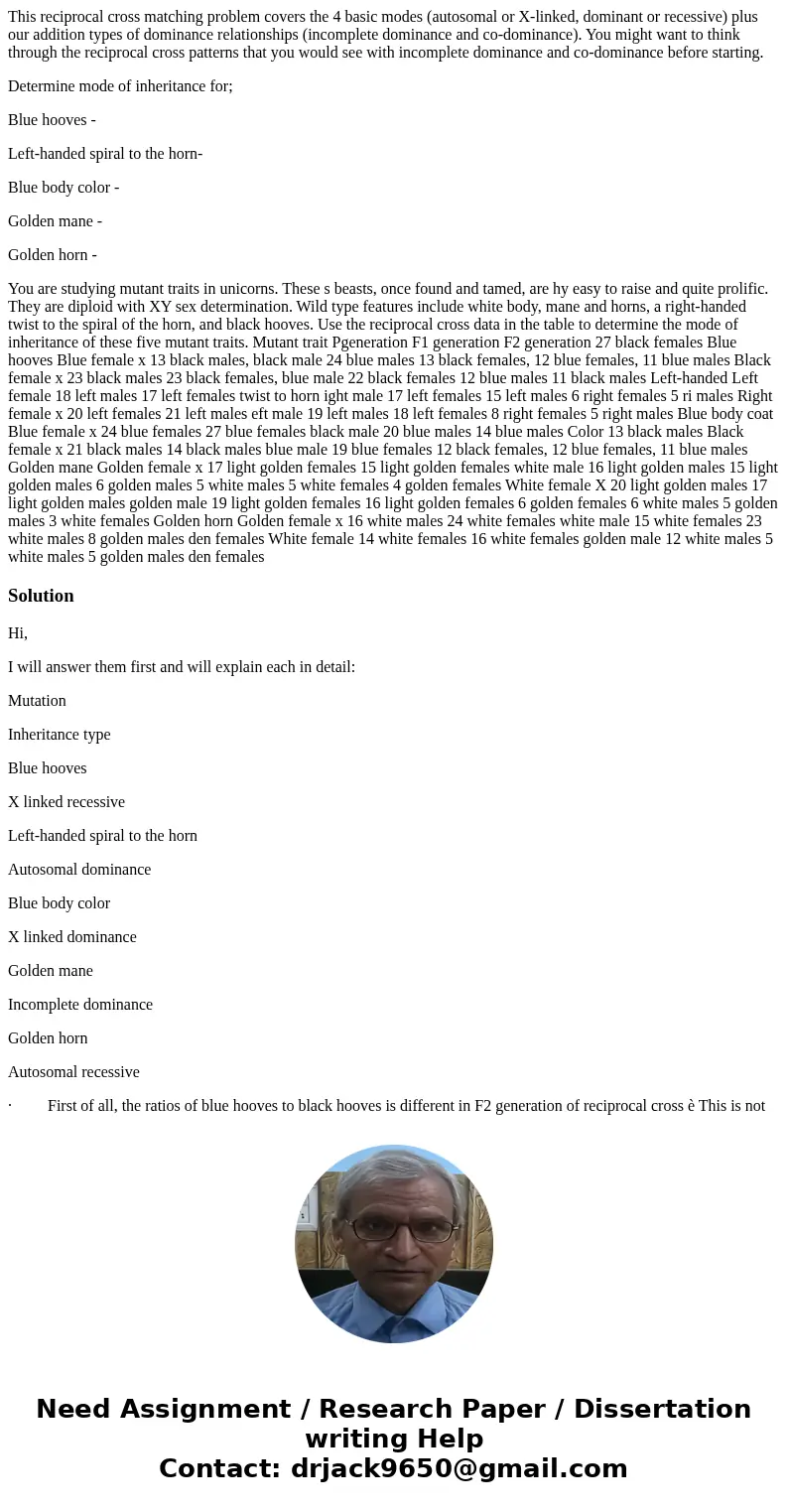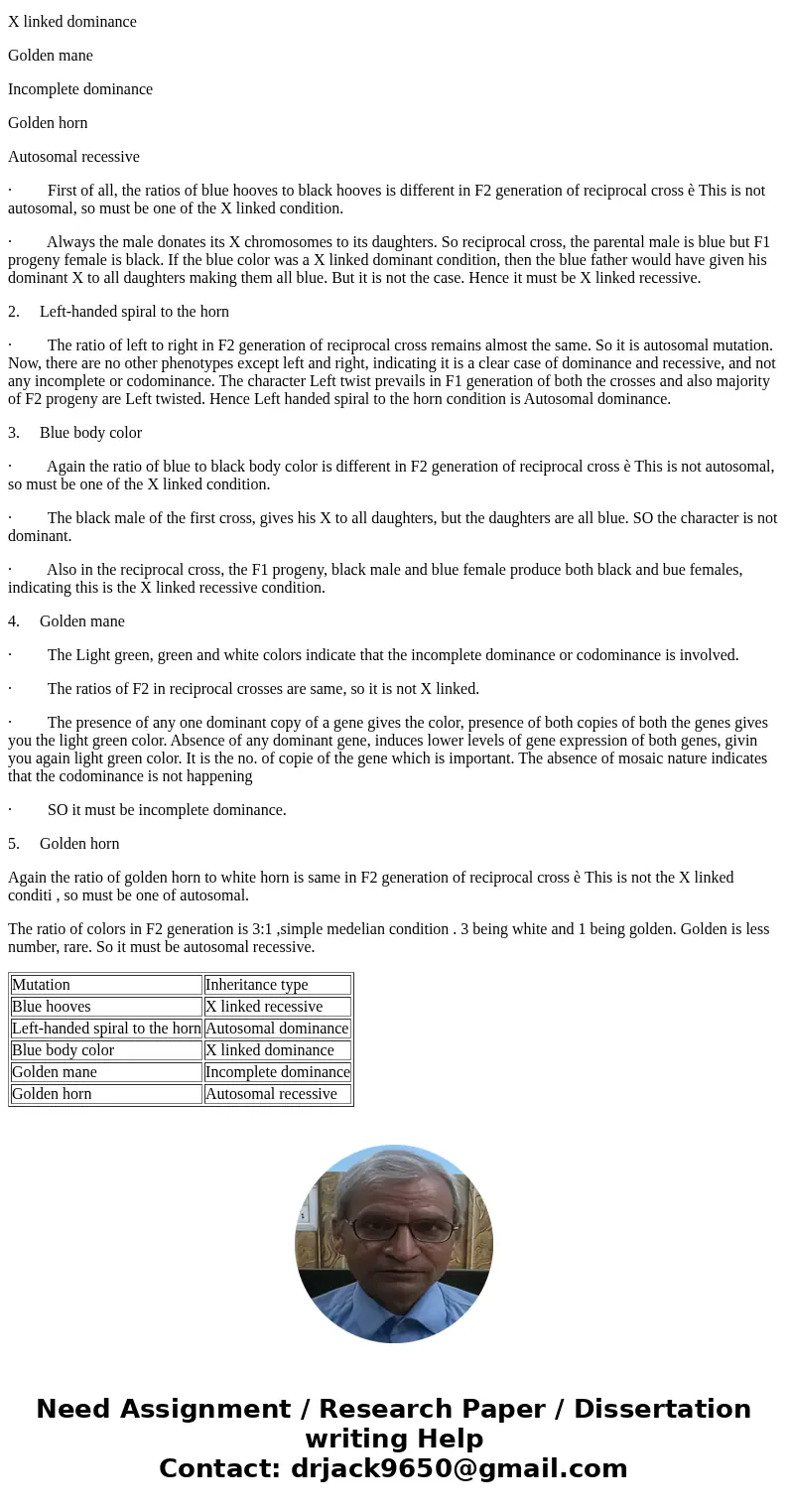This reciprocal cross matching problem covers the 4 basic mo
This reciprocal cross matching problem covers the 4 basic modes (autosomal or X-linked, dominant or recessive) plus our addition types of dominance relationships (incomplete dominance and co-dominance). You might want to think through the reciprocal cross patterns that you would see with incomplete dominance and co-dominance before starting.
Determine mode of inheritance for;
Blue hooves -
Left-handed spiral to the horn-
Blue body color -
Golden mane -
Golden horn -
You are studying mutant traits in unicorns. These s beasts, once found and tamed, are hy easy to raise and quite prolific. They are diploid with XY sex determination. Wild type features include white body, mane and horns, a right-handed twist to the spiral of the horn, and black hooves. Use the reciprocal cross data in the table to determine the mode of inheritance of these five mutant traits. Mutant trait Pgeneration F1 generation F2 generation 27 black females Blue hooves Blue female x 13 black males, black male 24 blue males 13 black females, 12 blue females, 11 blue males Black female x 23 black males 23 black females, blue male 22 black females 12 blue males 11 black males Left-handed Left female 18 left males 17 left females twist to horn ight male 17 left females 15 left males 6 right females 5 ri males Right female x 20 left females 21 left males eft male 19 left males 18 left females 8 right females 5 right males Blue body coat Blue female x 24 blue females 27 blue females black male 20 blue males 14 blue males Color 13 black males Black female x 21 black males 14 black males blue male 19 blue females 12 black females, 12 blue females, 11 blue males Golden mane Golden female x 17 light golden females 15 light golden females white male 16 light golden males 15 light golden males 6 golden males 5 white males 5 white females 4 golden females White female X 20 light golden males 17 light golden males golden male 19 light golden females 16 light golden females 6 golden females 6 white males 5 golden males 3 white females Golden horn Golden female x 16 white males 24 white females white male 15 white females 23 white males 8 golden males den females White female 14 white females 16 white females golden male 12 white males 5 white males 5 golden males den femalesSolution
Hi,
I will answer them first and will explain each in detail:
Mutation
Inheritance type
Blue hooves
X linked recessive
Left-handed spiral to the horn
Autosomal dominance
Blue body color
X linked dominance
Golden mane
Incomplete dominance
Golden horn
Autosomal recessive
· First of all, the ratios of blue hooves to black hooves is different in F2 generation of reciprocal cross è This is not autosomal, so must be one of the X linked condition.
· Always the male donates its X chromosomes to its daughters. So reciprocal cross, the parental male is blue but F1 progeny female is black. If the blue color was a X linked dominant condition, then the blue father would have given his dominant X to all daughters making them all blue. But it is not the case. Hence it must be X linked recessive.
2. Left-handed spiral to the horn
· The ratio of left to right in F2 generation of reciprocal cross remains almost the same. So it is autosomal mutation. Now, there are no other phenotypes except left and right, indicating it is a clear case of dominance and recessive, and not any incomplete or codominance. The character Left twist prevails in F1 generation of both the crosses and also majority of F2 progeny are Left twisted. Hence Left handed spiral to the horn condition is Autosomal dominance.
3. Blue body color
· Again the ratio of blue to black body color is different in F2 generation of reciprocal cross è This is not autosomal, so must be one of the X linked condition.
· The black male of the first cross, gives his X to all daughters, but the daughters are all blue. SO the character is not dominant.
· Also in the reciprocal cross, the F1 progeny, black male and blue female produce both black and bue females, indicating this is the X linked recessive condition.
4. Golden mane
· The Light green, green and white colors indicate that the incomplete dominance or codominance is involved.
· The ratios of F2 in reciprocal crosses are same, so it is not X linked.
· The presence of any one dominant copy of a gene gives the color, presence of both copies of both the genes gives you the light green color. Absence of any dominant gene, induces lower levels of gene expression of both genes, givin you again light green color. It is the no. of copie of the gene which is important. The absence of mosaic nature indicates that the codominance is not happening
· SO it must be incomplete dominance.
5. Golden horn
Again the ratio of golden horn to white horn is same in F2 generation of reciprocal cross è This is not the X linked conditi , so must be one of autosomal.
The ratio of colors in F2 generation is 3:1 ,simple medelian condition . 3 being white and 1 being golden. Golden is less number, rare. So it must be autosomal recessive.
| Mutation | Inheritance type |
| Blue hooves | X linked recessive |
| Left-handed spiral to the horn | Autosomal dominance |
| Blue body color | X linked dominance |
| Golden mane | Incomplete dominance |
| Golden horn | Autosomal recessive |


 Homework Sourse
Homework Sourse